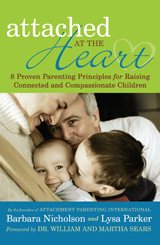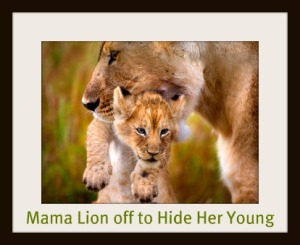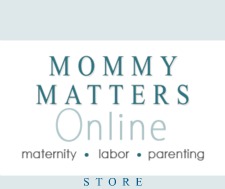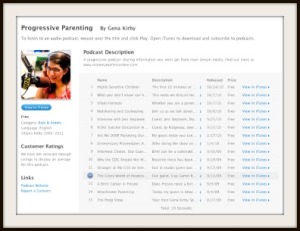“Babies that are held often cry less and are more calm and content.”*
There, that’s it, end of blog. I mean shouldn’t I just stop right here? Do parents need more than just this one sentence, to be convinced to hold and be close to their babies? They do? Well, okay here we go.
In our culture here in the United States, parents have a myriad of choices when it comes to baby gear. You can stock a huge hangar full of stuff to buy to prepare to become a parent. Swings, bouncy chairs, car seats, strollers, cribs etcetera, etcetera. It makes my head spin just wondering how we made it this far as a species without this stuff for millenia…………I just trailed off…sorry,I was just picturing cavemen and women putting their baby to sleep in a different cave.
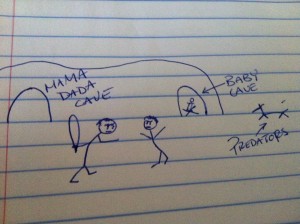
In earlier societies, a child's need to be close to his parents during both night and day was a "self-evident truth", and the obvious way to meet that need was to provide safety, closeness and comfort. Throughout most of human history, mothers slept next to their babies, which fostered the bond between them, and encouraged and facilitated breastfeeding.
DID CAVE MEN HAVE NURSERIES?
It’s kind of an absurd scene no? Ugg and Mugg leaving a cute little snack for the predators of the night…nope I don’t see it happening. It didn’t, for a reason. They carried their babies, they were with them hunting and gathering. Baby’s were close to mom. The mother new immediately if the baby needed to nurse, and nursed her baby, crying babies scared away prey or attracted unwanted predators.
But when you stroll through the humungo hangar baby store you see cribs everywhere. Many experts tell you that bed sharing is unsafe. Many of these experts are consortiums like the JPMA, the folks that make cribs. Before I go on, is there ANY MONEY to be made if we encourage parents to sleep with their children? Hmm…..
The following is a quote from Dr. Sears ”
A conflict of interest? Who is behind this new national campaign to warn parents not to sleep with their babies? In addition to the USCPSC, the Juvenile Products Manufacturers Association (JPMA) is co-sponsoring this campaign. The JPMA? An association of crib manufacturers. This is a huge conflict of interest. Actually, this campaign is exactly in the interest of the JPMA.
What does the research say? The September/October 2002 issue of Mothering Magazine presents research done throughout the whole world on the issue of safe sleep. Numerous studies are presented by experts of excellent reputation. And what is the magazine’s conclusion based on all this research? That not only is sleeping with your baby safe, but it is actually much safer than having your baby sleep in a crib. Research shows that infants who sleep in a crib are twice as likely to suffer a sleep related fatality (including SIDS) than infants who sleep in bed with their parents.
Education on safe sleep. I do support the USCPSC’s efforts to research sleep safety and to decrease the incidence of SIDS, but I feel they should go about it differently. Instead of launching a national campaign to discourage parents from sleeping with their infants, the U.S. Consumer Product Safety Commission should educate parents on how to sleep safely with their infants if they choose to do so.
A DIFFERENT POINT OF VIEW
“Cribs are dangerous, and prevent parents from intervening quickly in emergencies. The U.S. Consumer Product Safety Commission, the same organization that recently warned about family beds, has reported 40 to 50 crib deaths per year, and thousands of serious injuries. Their own web site is filled with warnings of the potential hazards of crib use. Yet they never consider the possibility that cribs should be abandoned. This is a nonsensical double standard that no one seems to be questioning.” Jan Hunt, M.Sc Director of The Natural Child Movement.
WHAT KIND OF MAMMALS ARE WE?
There are two types of mammals, cache and carry mammals. The cache mammals are those that leave their babies in hiding for long periods of time so the mother can hunt for food. These mothers have milk high in fat and protein, allowing their babies to sleep for long periods of time in order not to attract a predator with their cries.
The carry (that’s us) species are those mammals whose babies are relatively immature and must be on their mother’s bodies or in very close proximity. These mothers produce milk that is low in fat and protein, which digests quickly, guaranteeing that the baby will be hungry more frequently. This forces the mother to stay close by, ideally having the baby on her body so they can move together quickly if needed to escape a dangerous situation. Human babies are by far the most immature babies born, needing constant care, including feeding, holding, rocking, and other soothing behaviors. Unfortunately, Western culture has traditionally treated human babies as if they were more like cache animals, trying to invent ways to keep them quiet and alone for as long as possible, especially at night. This can force babies to go against their biology and, in some cases, lead to failure to thrive.
WE ALL NEED TO BE TOUCHED
Researchers in the United States and England have found that on average, babies in these countries are only touched or held for approximately 25 percent of their daytime hours. By nine months of age, the touch time goes down to 16 percent. Even young infants in a model day care center were only touched 14 percent of the day. In contrast, studies done with the !Kung San tribe in Africa found that infants are in touch with their mothers for approximately 70 percent of the day and in someone else’s arms the rest of the time. These babies cry much less than Western babies.
THE CASE AGAINST CONTAINERS
Plagiocephaly, what is it?
plagiocephaly (plāˈ·jē·![]() ·seˑ·f
·seˑ·f![]() ·lē),
·lē),
According to Ask.com.Pediatrics:
”
Prevention
Since posterior plagiocephaly is caused by there being too much pressure being put on one part of your infant’s head, you can often prevent it from occuring by alternating the positions that your infant stays in. This does not mean that you should stop putting your child to sleep on their backs, put you can alternate your child’s head position that he usually sleeps with.Spending more time on his stomach (prone position) in ‘tummy time’ when he is awake and being supervised is also a good idea. And try to avoid letting your infant spend a lot of time in the same position on his back when he is awake. This may mean avoiding leaving your infant in car seats, when he is not in a car, and bouncy type seats for long periods of time. An infant sling or wrap can be a better alternative, as they put less pressure on your child’s head, or use a stationary walker once your child is old enough to sit in one.
These preventative measures can be especially important for infants at higher risk of positional plagiocephaly, including preemies, multiples, and infants with poor muscle tone.
When should you start? Usually during the newborn period, when an infant’s skull is ‘maximally deformable.'”
When you carry your baby, he/she is forced to keep her head up, he/she using their core muscles and will develop these muscles faster than their crib lying, car seat sleeping, bouncy seat bucking friends.
For more information on these ideas OR a great gift for parents who want to know more about them : 